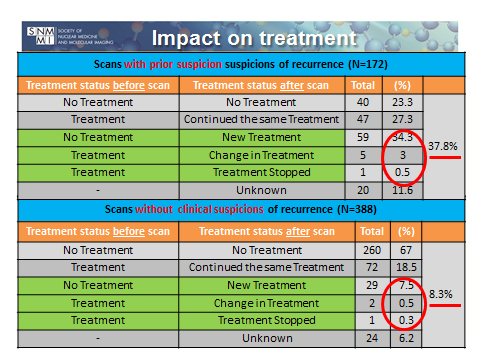SNMMI 2015: Follow-up PET/CT scans add value for non-Hodgkin lymphoma patients
Charts courtesy of Mehdi Taghipour, Johns Hopkins Medical Institutions
Follow-up PET/CT scans add value to the clinical assessment and management of non-Hodgkin lymphoma (NHL) patients, according to a study of 204 patients treated at the Johns Hopkins Medical Institutions in Baltimore that was presented at the annual meeting of the Society of Nuclear Medicine and Molecular Imaging (SNMMI) held in Baltimore this month. The use of PET/CT changed patient management for 17% and initiated new treatments for 15.7%. What is notable is that 22% of the follow-up scans showed suspected disease when there was no clinical suspicion of disease recurrence. The accuracy of FDG –PET/CT in detecting recurring lymphoma among the patients in the study was 92.1%.

 “Post-treatment surveillance with molecular imaging can mean the early start of a new, life-saving treatment,” lead author and research fellow from Johns Hopkins’ Department of Radiology Medhi Taghipour, M.D., told attendees. NHL is the fifth most prevalent cancer in the United States, with an estimated 71,850 individuals being diagnosed with NHL according to 2015 statistics from the American Cancer Society. The disease can range from being relatively easy to treat to being very aggressive. Dr. Taghipour said that the majority of NHL patients are treated successfully with frontline chemotherapy, but about 20% to 50% with aggressive lymphoma tend to relapse within three years. Functional and structural imaging with a combination of PET/CT has the potential to catch a relapse in its earliest stages.
“Post-treatment surveillance with molecular imaging can mean the early start of a new, life-saving treatment,” lead author and research fellow from Johns Hopkins’ Department of Radiology Medhi Taghipour, M.D., told attendees. NHL is the fifth most prevalent cancer in the United States, with an estimated 71,850 individuals being diagnosed with NHL according to 2015 statistics from the American Cancer Society. The disease can range from being relatively easy to treat to being very aggressive. Dr. Taghipour said that the majority of NHL patients are treated successfully with frontline chemotherapy, but about 20% to 50% with aggressive lymphoma tend to relapse within three years. Functional and structural imaging with a combination of PET/CT has the potential to catch a relapse in its earliest stages.
“Early diagnosis of a relapse is essential,” said Dr. Taghipour. “PET/CT imaging is superior to conventional imaging for NHL, but the role of post-treatment PET/CT has been controversial. The study we conducted proves that 39% of follow-up PET/CT scans added clinical value.”
The study Dr. Taghipour and his colleagues undertook included 204 patients with NHL who had at least one follow-up PET/CT six months after the completion of their treatment. They had a total of 560 PET/CT scans performed. Three hundred eighty-eight scans were ordered for routine followup. The other 172 were ordered to confirm or rule out suspicion of a relapse.
Nearly three-fourths of the scans performed did not change treatment management. But management was changed for 15.7% and the treatment modality was changed or stopped after 1.6% of the scans were performed. The sensitivity and specificity of FDG-PET/CT were 95.1% and 90.5% respectively. Negative predictive value (NPV) was 97.1% and positive predictive value (PPV) was 84.5%.
REFERENCE
- Taghipour M, Marcus C, Nunna P et al. Follow up FDG PET/CT for Recurrence Detection and Survival Outcome Prediction in Patients with non-Hodgkin lymphoma. J Nucl Med. 2015; 56 (Suppl. 3): 599.
